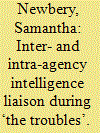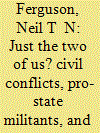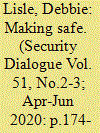| Srl | Item |
| 1 |
ID:
181043


|
|
|
|
|
| Summary/Abstract |
Intelligence is crucial to success in counter-terrorism, and successful intelligence work involves effective liaison between and within all the organisations involved. Scholars rarely address intelligence in counter-terrorism other than through case studies, while studies of intelligence in counter-insurgency and studies of international intelligence liaison emphasise the value of intelligence liaison with little attention to how it works in practice. This article substantially expands existing knowledge and understanding by focusing on intelligence coordination within Northern Ireland in the 1990s. It draws on heretofore unexploited, yet voluminous, original material. It analyses the contribution that computerisation made to inter-agency liaison, the contribution the Northern Ireland Prison Service made to intelligence work, the role played by intra- and inter-agency structures and the valuable work that the right individuals in the right posts can do. This article thereby provides a broader and deeper understanding of the challenges faced by state agencies and how some of these were overcome to facilitate inter- and intra-agency intelligence liaison in Northern Ireland in the 1990s. It therefore contributes to emerging theory that seeks to explain intelligence.
|
|
|
|
|
|
|
|
|
|
|
|
|
|
|
|
| 2 |
ID:
152873


|
|
|
|
|
| Summary/Abstract |
Quantitative literature discussing violence in civil conflicts tends towards a typical model of engagement between governments and revolutionaries. Whilst recent work has shown the significant impact of multiple anti-government groups, a further feature remains understudied—the role of pro-state militants. This article theorizes a “violence premium” when such groups arise, which leads to all connected groups devoting greater energy to conflict than they would in isolation. Employing duration analysis and data from The Troubles in Northern Ireland, where Republicans act as revolutionary insurgents, Loyalists as pro-state militants, and the British Army as government forces, the violence premium is empirically confirmed. Both Loyalists and Republicans deviate from their underlying strategies to attack more frequently when violence by their rivals increases, with Republicans and the British Army engaging in the same way. An extended analysis, accounting for the status of the victim, shows that the violence premium resulting from interaction between Loyalists and Republicans targeted only the civilian population of Northern Ireland, elucidating the sectarian component of The Troubles. These results show that including all conflict parties and considering how they are linked are important features in studies that aim to determine the net level of violence in civil conflicts.
|
|
|
|
|
|
|
|
|
|
|
|
|
|
|
|
| 3 |
ID:
175121


|
|
|
|
|
| Summary/Abstract |
In the Ulster Museum’s new gallery The Troubles and Beyond, the central display showcases a Wheelbarrow bomb disposal robot. This machine was invented by the British Army in Northern Ireland in 1972 and used by officers of the 321 Explosive Ordinance Disposal Squadron (321EOD) to defuse car bombs planted by the Irish Republican Army (IRA). This article offers an alternative history of that machine – a dirtier history – that critically assesses its role during the Troubles. Centrally, the article contests the British Army’s preferred account of this machine as a ‘game-changing’ technological innovation in counterinsurgency, and their understanding of themselves as benign peacekeepers. Rather than figure the Wheelbarrow robot as an unreadable ‘black box’ used instrumentally by the superior human operators of 321EOD, this article seeks to foreground the unruly transfers of agency between the machine and its operators as they tested and experimented in the exceptional colonial laboratory of Northern Ireland. The article further explores the machine’s failures during bomb disposal episodes, the collateral damage that resulted, and the multiple and often unruly reactions of local populations who watched the Wheelbarrow robot at work. Providing a ‘dirty history’ of the Wheelbarrow robot is an effort to demonstrate that war can never be fully cleaned up, either through militarized mythologies of technological innovation or hopeful museum displays.
|
|
|
|
|
|
|
|
|
|
|
|
|
|
|
|